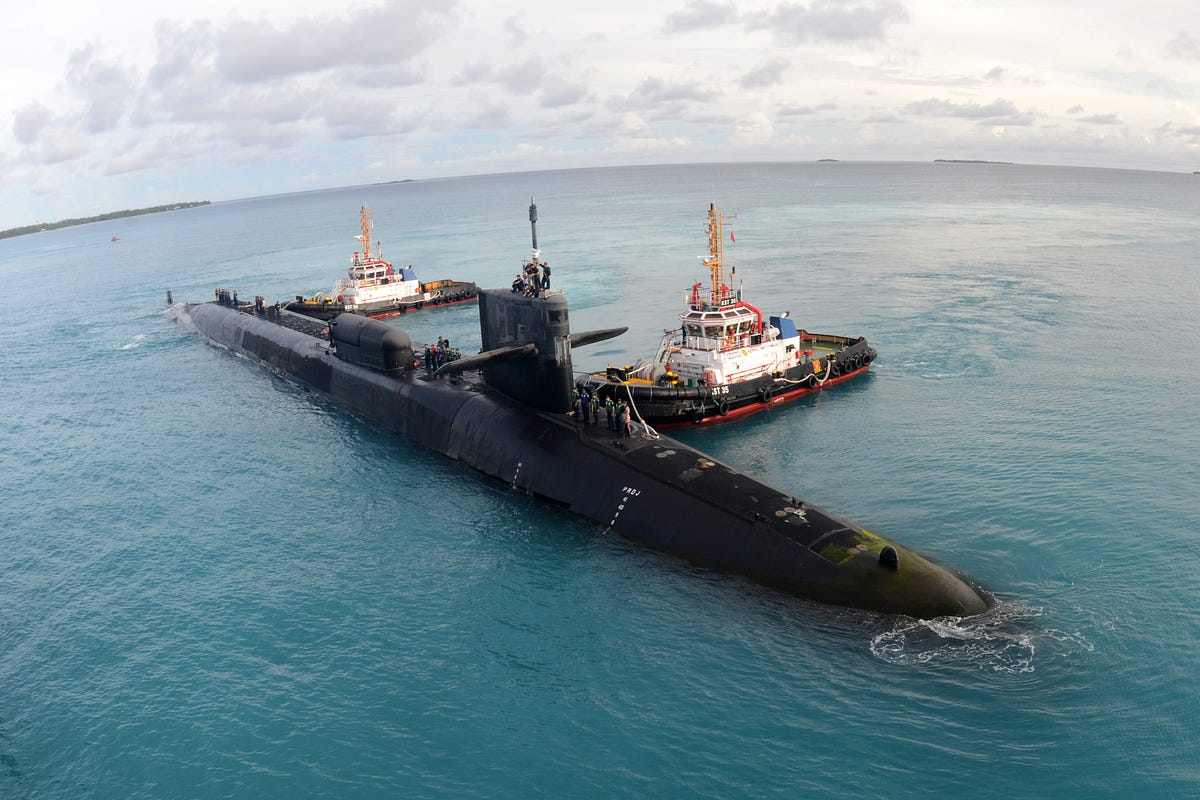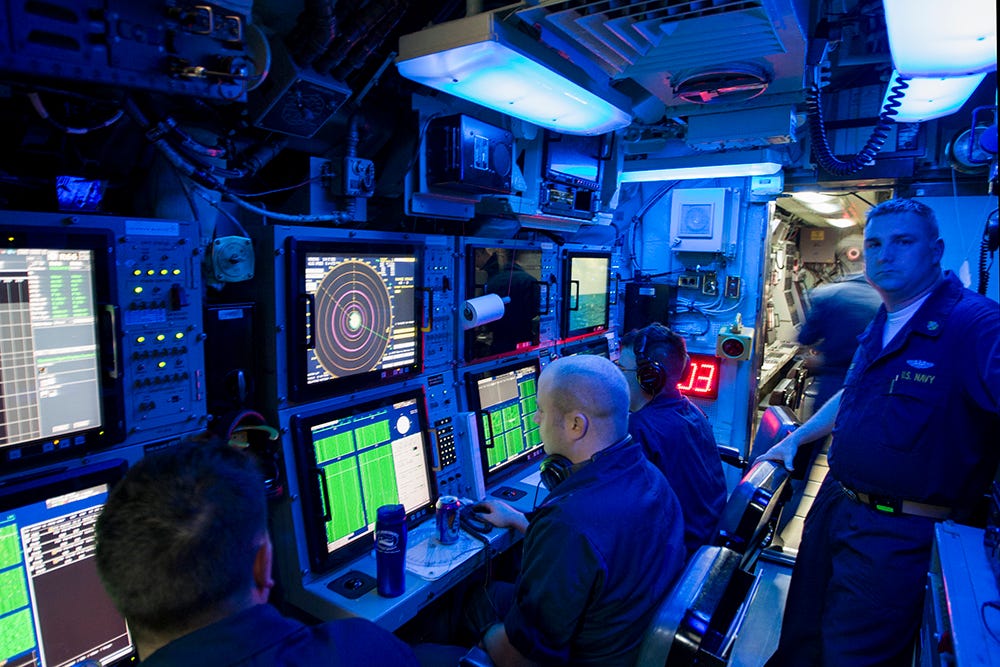But Beijing doesn’t seem to take into account U.S. submarines
David Axe in War is Boring
The bad news first. The People’s Republic of China now believes it can successfully prevent the United States from intervening in the event of a Chinese invasion of Taiwan or some other military assault by Beijing.
Now the good news. China is wrong—and for one major reason. It apparently disregards the decisive power of America’s nuclear-powered submarines.
Moreover, for economic and demographic reasons Beijing has a narrow historical window in which to use its military to alter the world’s power structure. If China doesn’t make a major military move in the next couple decades, it probably never will.
The U.S. Navy’s submarines—the unsung main defenders of the current world order—must hold the line against China for another 20 years. After that, America can declare a sort of quiet victory in the increasingly chilly Cold War with China.
 A
A
Chinese Type 071 amphibious assault ship. Via Chinese Internet
How China wins
The bad news came from Lee Fuell, from the U.S. Air Force’s National Air and Space Intelligence Center, during Fuell’s testimony before the U.S.-China Economic and Security Review Commission in Washington, D.C. on Jan. 30.
For years, Chinese military planning assumed that any attack by the People’s Liberation Army on Taiwan or a disputed island would have to begin with a Pearl Harbor-style preemptive missile strike by China against U.S. forces in Japan and Guam. The PLA was so afraid of overwhelming American intervention that it genuinely believed it could not win unless the Americans were removed from the battlefield before the main campaign even began.
A preemptive strike was, needless to say, a highly risky proposition. If it worked, the PLA just might secure enough space and time to defeat defending troops, seize territory and position itself for a favorable post-war settlement.
But if China failed to disable American forces with a surprise attack, Beijing could find itself fighting a full-scale war on at least two fronts: against the country it was invading plus the full might of U.S. Pacific Command, fully mobilized and probably strongly backed by the rest of the world.
That was then. But after two decades of sustained military modernization, the Chinese military has fundamentally changed its strategy in just the last year or so. According to Fuell, recent writings by PLA officers indicate “a growing confidence within the PLA that they can more-readily withstand U.S. involvement.”
The preemptive strike is off the table—and with it, the risk of a full-scale American counterattack. Instead, Beijing believes it can attack Taiwan or another neighbor while also bloodlessly deterring U.S. intervention. It would do so by deploying such overwhelmingly strong military forces—ballistic missiles, aircraft carriers, jet fighters and the like—that Washington dare not get involved.
The knock-on effects of deterring America could be world-changing. “Backing away from our commitments to protect Taiwan, Japan or the Philippines would be tantamount to ceding East Asia to China’s domination,” Roger Cliff, a fellow at the Atlantic Council, said at the same U.S.-China Economic and Security Review Commission hearing on Jan. 30.
Worse, the world’s liberal economic order—and indeed, the whole notion of democracy—could suffer irreparable harm. “The United States has both a moral and a material interest in a world in which democratic nations can survive and thrive,” Cliff asserted.
Fortunately for that liberal order, America possesses by far the world’s most powerful submarine force—one poised to quickly sink any Chinese invasion fleet. In announcing its readiness to hold off the U.S. military, the PLA seems to have ignored Washington’s huge undersea advantage.

The missile submarine USS ‘Georgia.’ Navy photo
The Silent Service
It’s not surprising that Beijing would overlook America’s subs. MostAmericans overlook their own undersea fleet—and that’s not entirely their own fault. The U.S. sub force takes pains to avoid media coverage in order to maximize its secrecy and stealth. “The submarine cruises the world’s oceans unseen,” the Navy stated on its Website.
Unseen and unheard. That why the sub force calls itself the “Silent Service.”
The Navy has 74 submarines, 60 of which are attack or missile submarines optimized for finding and sinking other ships or blasting land targets. The balance is ballistic-missile boats that carry nuclear missiles and would not routinely participate in military campaigns short of an atomic World War III.
Thirty-three of the attack and missile boats belong to the Pacific Fleet, with major bases in Washington State, California, Hawaii and Guam. Deploying for six months or so roughly every year and a half, America’s Pacific subs frequently stop over in Japan and South Korea and occasionally even venture under the Arctic ice.
According to Adm. Cecil Haney, the former commander of Pacific Fleet subs, on any given day 17 boats are underway and eight are “forward-deployed,” meaning they are on station in a potential combat zone. To the Pacific Fleet, that pretty much means waters near China.
America has several submarine types. The numerous Los Angeles-class attack boats are Cold War stalwarts that are steadily being replaced by newerVirginia-class boats with improved stealth and sensors. The secretiveSeawolfs, numbering just three—all of them in the Pacific—are big, fast and more heavily armed than other subs. The Ohio-class missile submarines are former ballistic missile boats each packing 154 cruise missile.
U.S. subs are, on average, bigger, faster, quieter and more powerful than the rest of the world’s subs. And there are more of them. The U.K. is building just seven new Astute attack boats. Russia aims to maintain around 12 modern attack subs. China is struggling to deploy a handful of rudimentary nuclear boats.
Able to lurk silently under the waves and strike suddenly with torpedoes and missiles, submarines have tactical and strategic effect greatly disproportionate to their relatively small numbers. During the 1982 Falklands War, the British sub Conqueror torpedoed and sank the Argentine cruiserGeneral Belgrano, killing 323 men. The sinking kept the rest of the Argentine fleet bottled up for the duration of the conflict.
America’s eight-at-a-time submarine picket in or near Chinese waters could be equally destructive to Chinese military plans, especially considering the PLA’s limited anti-submarine skills. “Although China might control the surface of the sea around Taiwan, its ability to find and sink U.S. submarines will be extremely limited for the foreseeable future,” Cliff testified. “Those submarines would likely be able to intercept and sink Chinese amphibious transports as they transited toward Taiwan.”
So it almost doesn’t matter that a modernized PLA thinks it possesses the means to fight America above the waves, on land and in the air. If it can’t safely sail an invasion fleet as part of its territorial ambitions, it can’t achieve its strategic goals—capturing Taiwan and or some island also claimed by a neighboring country—through overtly military means.
That reality should inform Washington’s own strategy. As the United States has already largely achieved the world order it struggled for over the last century, it need only preserve and defend this order. In other words, America has the strategic high ground against China, as the latter must attack andalter the world in order to get what it wants.
In practical military terms, that means the Pentagon can more or less ignore most of China’s military capabilities, including those that appear to threaten traditional U.S. advantages in nukes, air warfare, mechanized ground operations and surface naval maneuvers.
“We won’t invade China, so ground forces don’t play,” pointed out Wayne Hughes, a professor at the U.S. Naval Postgraduate School. “We won’t conduct a first nuclear strike. We should not adopt an air-sea strike plan against the mainland, because that is a sure way to start World War IV.”
Rather, America must deny the Chinese free access to their near waters. “We need only enough access to threaten a war at sea,” Hughes said. In his view, a fleet optimized for countering China would have large numbers of small surface ships for enforcing a trade blockade. But the main combatants would be submarines, “to threaten destruction of all Chinese warships and commercial vessels in the China Seas.”
Cliff estimated that in wartime, each American submarine would be able to get off “a few torpedo shots” before needing to “withdraw for self-preservation.” But assuming eight subs each fire three torpedoes, and just half those torpedoes hit, the American attack boats could destroy all of China’s major amphibious ships—and with them, Beijing’s capacity for invading Taiwan or seizing a disputed island.

The sonar room on the USS ‘Toledo.’ Bryan William Jones photo
Waiting out the Chinese decline
If American subs can hold the line for another 20 years, China might age right out of its current, aggressive posture without ever having attacked anyone. That’s because economic and demographic trends in China point towards a rapidly aging population, flattening economic growth and fewer resources available for military modernization.
To be fair, almost all developed countries are also experiencing this aging, slowing and increasing peacefulness. But China’s trends are pronounced owing to a particularly steep drop in the birth rate traceable back to the Chinese Communist Party’s one-child policy.
Another factor is the unusual speed with which the Chinese economy has expanded to its true potential, thanks to the focused investment made possible by an authoritarian government … and also thanks to that government’s utter disregard for the natural environment and for the rights of everyday Chinese people.
“The economic model that propelled China through three decades of meteoric growth appears unsustainable,” Andrew Erickson, a Naval War College analyst, told the U.S.-China Economic and Security Review Commission.
What Erickson described as China’s “pent-up national potential” could begin expiring as early as 2030, by which point “China will have world’s highest proportion of people over 65,” he predicted. “An aging society with rising expectations, burdened with rates of chronic diseases exacerbated by sedentary lifestyles, will probably divert spending from both military development and the economic growth that sustains it.”
Wisely, American political and military leaders have made the investments necessary to sustain U.S. undersea power for at least that long. After a worrying dip in submarine production, starting in 2012 the Pentagon asked for—and Congress funded—the acquisition of two Virginia-class submarines per year for around $2.5 billion apiece, a purchase rate adequate to maintain the world’s biggest nuclear submarine fleet indefinitely.
The Pentagon is also improving the Virginia design, adding undersea-launched drones, extra missile capacity and potentially a new anti-ship missile.
Given China’s place in the world, its underlying national trends and America’s pointed advantage in just that aspect of military power that’s especially damaging to Chinese plans, it seems optimistic for PLA officers to assume they can launch an attack on China’s neighbors without first knocking out U.S. forces.
Not that a preemptive strike would make any difference, as the only American forces that truly matter for containing China are the very ones that China cannot reach.
For they are deep underwater.
David Axe’s new book Shadow Wars is out. Sign up for a daily War is Boring email update here. Subscribe to WIB’s RSS feed here and follow the main page here.
No comments:
Post a Comment